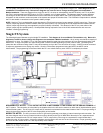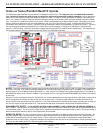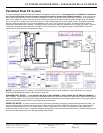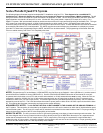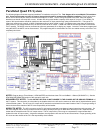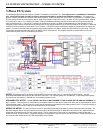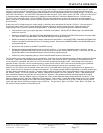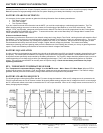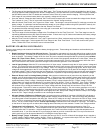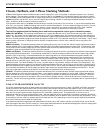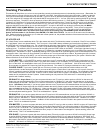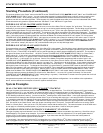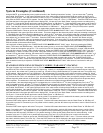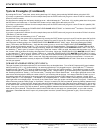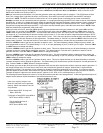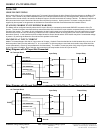
Copyright 2003 OutBack Power Systems, Inc. FX & VFX Series Inverter/Charger System Installation & Programming Manual
19009 62
nd
Ave NE, Arlington WA 98223 USA 900-0027-1
Tel 360 435 6030 Fax 360 435 6019
Rev 7.2 08/26/05 Page 25
BATTERY CHARGING INFORMATION
The following bullets describe the steps in the battery charging sequence.
• The first stage of the charging sequence is the “Bulk” stage. The FX uses as much AC current as possible from the AC input
source to raise the battery voltage to the “Absorb” voltage setting. See the “Maximum Current for Battery Charging” heading in
the RATINGS section for the FX’s default and maximum values of the AC current used for charging. The time period of the
“Bulk” stage will vary with the battery bank’s age, capacity, voltage and AC source.
• Once the “Absorb” voltage has been reached, the FX will use the necessary AC current to sustain this voltage for the “Absorb
Time” (default of 1 hour). The AC current will decrease as the “Absorb” charge continues.
• After the “Absorb Time Period”, the FX goes into “Silent” mode. The charger is turned off and the FX continues to monitor the
battery voltage. If a generator has been automatically started on a low voltage condition using AGS (see MATE manual), the
FX will automatically turn off the generator after the “Absorb Time Period”.
• If a generator has been manually started or the utility grid is connected, the FX will let the battery voltage drop to the “Refloat”
voltage and then it will start a ‘Float’ charge.
• The ‘Float’ stage will raise the battery voltage to the “Float Setpoint” for the “Float Time Limit”. The ‘Float’ stage is meant for
maintaining batteries that have DC loads connected to them. If there aren’t any DC loads on the batteries, the battery voltage
will usually remain above the “Refloat” voltage set point.
• After the “Float Time Limit” (default of 1 hour), the FX goes back into ‘Silent’ mode and waits until the battery voltage drops to
the ‘Refloat’ voltage again. It then repeats the ‘Float’ charge for the “Float Time Period”. The FX will continue this cycle of
‘Silent’, ‘Refloat’ and ‘Float’ until the AC source is disconnected.
BATTERY CHARGING CONSTRAINTS
There are some settings and situations that affect the battery charging process. These settings and situations are described by the
following bullets.
• Rated Continuous Current of the AC Input Source: This applies to generators only since the utility grid can produce power
levels much higher. This setting is for the maximum AC generator current (at 120 VAC) that the FX will accept before is turns
down its charger. This setting is called “AC/2 Gen Limit” and can be accessed through the MATE by following the path Main /
Setup / FX / Input / Down / Down. The rated continuous AC current of the generator should be set in this screen. When the
combined AC current used by the FX’s charger and the loads connected to the FX’s AC output exceed this “AC/2 Gen Limit”
the FX will reduce the AC current used for the charger to ensure that the generator is not overloaded.
• Low AC Input Voltage: When the FX is connected to an AC input source, it passes through the AC input sources’ voltage and
current. The FX has minimum and maximum voltage settings for the AC input source to ensure that the AC input source does
not damage downstream loads with low or high voltage. If the FX is charging and passing through power, the AC input source
voltage can be dragged down to the FX’s low voltage limit. When this happens, the FX will back off the charger to sustain an
acceptable voltage. If the FX goes below the low voltage limit, it will disconnect from the AC input source and cease charging.
If you are experiencing low AC input voltage from a generator it is possible to adjust some generators to raise their voltage.
• External “Dump Load” is Limiting Battery Voltage: Many systems include sources of power that vary depending on the
weather, such as wind turbines and micro-hydro systems. In high wind or water conditions, these power sources can produce
voltages above what the battery bank should handle. These systems often use “Dump Loads” to get rid of this extra power at
a particular battery “Dump” voltage. Sometimes the battery “Dump” voltage is below the FX’s ‘”Target” voltage (‘”Target’’
voltage refers to a voltage set point that the FX is trying to reach; like “Absorb”, “Float” or “Equalize”). If the “Dump” voltage is
below the “Target” voltage, the FX will never reach the “Target” because the “Dump Load” limits the battery voltage. The FX
will continue to try to charge the batteries to the “Target” voltage while the “Dump Load” will continue to “Dump” the FX’s
charging power. Since the FX wants to complete a charge, it will be stuck charging. This can cause a generator to run until it
runs out of gas or, if connected to the utility grid, it can cause a lot of unnecessary power consumption ($$$). To remedy this
situation, reduce the FX’s “Target” voltage to a value slightly below the “Dump Load” voltage or raise the “Dump Load” voltage
above the FX’s “Target” voltage (remember not to overcharge the batteries).
• AC Input Voltage is Different on Different Legs: In systems that have multiple AC input legs (120/240 VAC split phase or
120/208 VAC three phase) there are often slightly different voltages present on each leg. This is more likely with generators
since their power is small compared to the utility grid. When the AC voltage on one leg is reduced to the FX’s AC input “Lower
Limit”, the FX(‘s) connected to that particular leg will reduce their charging current so as not to disconnect from the AC input
source. This is a similar situation as the “Low AC Input Voltage” bullet above but with multiple AC input legs. The other FXs
on the other AC input legs will not reduce their charging rates unless they too have reached a “Lower Limit” voltage condition.
• Temperature Limit is Reached: Each FX has three temperature sensors that measure the temperature of the FX’s
capacitors, FETs, and transformer. These temperature sensors will indicate when a temperature has been reached that will
adversely affect the FX’s operation. At these temperatures, the FX will back off the charger to reduce the temperature to a
sustainable level. If you notice that the FX is not charging as hard as you think it should and the FX is very hot to the touch
(and it gets hot!) you can be assured that the FX is limiting the charge due to heat.
• Battery Voltage “Target” is Reached: In a system that has only one FX, that FX will back off the charger when it reaches a
“Target” voltage (“Target” voltage is either “Absorb”, “Float” or “Equalize”). In a system with multiple FX’s, the “Slave” FX’s will
back off before the “Master” FX, leaving the “Master” FX to finish the charge.



